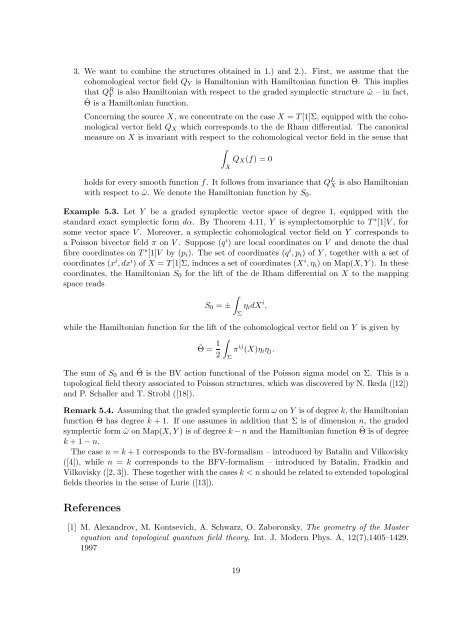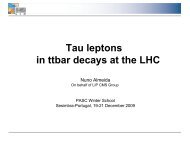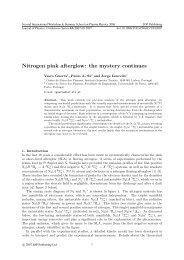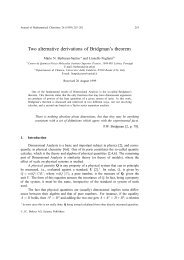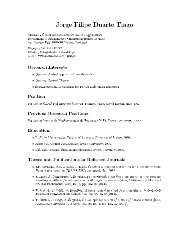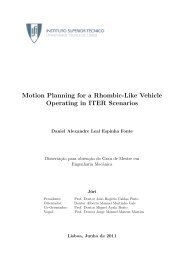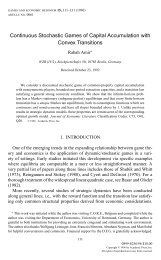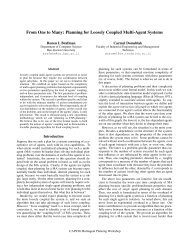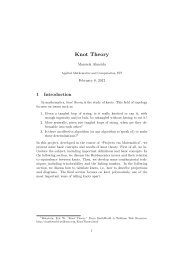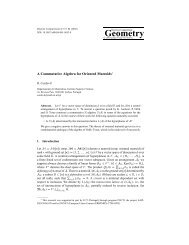Introduction to supergeometry
Introduction to supergeometry
Introduction to supergeometry
You also want an ePaper? Increase the reach of your titles
YUMPU automatically turns print PDFs into web optimized ePapers that Google loves.
3. We want <strong>to</strong> combine the structures obtained in 1.) and 2.). First, we assume that the<br />
cohomological vec<strong>to</strong>r field Q Y is Hamil<strong>to</strong>nian with Hamil<strong>to</strong>nian function Θ. This implies<br />
that Q R Y<br />
is also Hamil<strong>to</strong>nian with respect <strong>to</strong> the graded symplectic structure ˆω – in fact,<br />
ˆΘ is a Hamil<strong>to</strong>nian function.<br />
Concerning the source X, we concentrate on the case X = T [1]Σ, equipped with the cohomological<br />
vec<strong>to</strong>r field Q X which corresponds <strong>to</strong> the de Rham differential. The canonical<br />
measure on X is invariant with respect <strong>to</strong> the cohomological vec<strong>to</strong>r field in the sense that<br />
∫<br />
Q X (f) = 0<br />
X<br />
holds for every smooth function f. It follows from invariance that Q L X<br />
with respect <strong>to</strong> ˆω. We denote the Hamil<strong>to</strong>nian function by S 0 .<br />
is also Hamil<strong>to</strong>nian<br />
Example 5.3. Let Y be a graded symplectic vec<strong>to</strong>r space of degree 1, equipped with the<br />
standard exact symplectic form dα. By Theorem 4.11, Y is symplec<strong>to</strong>morphic <strong>to</strong> T ∗ [1]V , for<br />
some vec<strong>to</strong>r space V . Moreover, a symplectic cohomological vec<strong>to</strong>r field on Y corresponds <strong>to</strong><br />
a Poisson bivec<strong>to</strong>r field π on V . Suppose (q i ) are local coordinates on V and denote the dual<br />
fibre coordinates on T ∗ [1]V by (p i ). The set of coordinates (q i , p i ) of Y , <strong>to</strong>gether with a set of<br />
coordinates (x i , dx i ) of X = T [1]Σ, induces a set of coordinates (X i , η i ) on Map(X, Y ). In these<br />
coordinates, the Hamil<strong>to</strong>nian S 0 for the lift of the de Rham differential on X <strong>to</strong> the mapping<br />
space reads<br />
∫<br />
S 0 = ± η i dX i ,<br />
Σ<br />
while the Hamil<strong>to</strong>nian function for the lift of the cohomological vec<strong>to</strong>r field on Y is given by<br />
ˆΘ = 1 ∫<br />
π ij (X)η i η j .<br />
2<br />
Σ<br />
The sum of S 0 and ˆΘ is the BV action functional of the Poisson sigma model on Σ. This is a<br />
<strong>to</strong>pological field theory associated <strong>to</strong> Poisson structures, which was discovered by N. Ikeda ([12])<br />
and P. Schaller and T. Strobl ([18]).<br />
Remark 5.4. Assuming that the graded symplectic form ω on Y is of degree k, the Hamil<strong>to</strong>nian<br />
function Θ has degree k + 1. If one assumes in addition that Σ is of dimension n, the graded<br />
symplectic form ˆω on Map(X, Y ) is of degree k − n and the Hamil<strong>to</strong>nian function ˆΘ is of degree<br />
k + 1 − n.<br />
The case n = k + 1 corresponds <strong>to</strong> the BV-formalism – introduced by Batalin and Vilkovisky<br />
([4]), while n = k corresponds <strong>to</strong> the BFV-formalism – introduced by Batalin, Fradkin and<br />
Vilkovisky ([2, 3]). These <strong>to</strong>gether with the cases k < n should be related <strong>to</strong> extended <strong>to</strong>pological<br />
fields theories in the sense of Lurie ([13]).<br />
References<br />
[1] M. Alexandrov, M. Kontsevich, A. Schwarz, O. Zaboronsky, The geometry of the Master<br />
equation and <strong>to</strong>pological quantum field theory, Int. J. Modern Phys. A, 12(7),1405–1429,<br />
1997<br />
19


